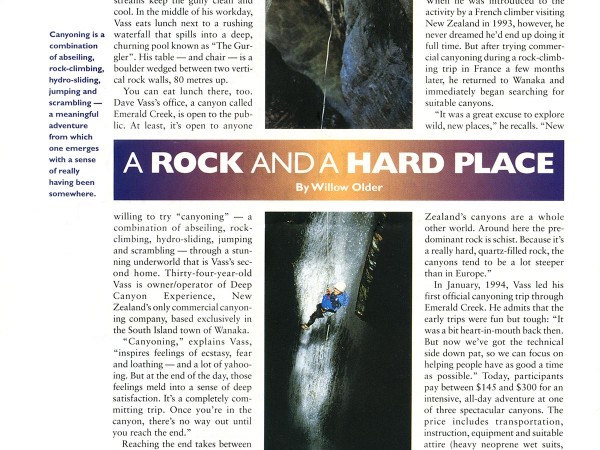
Pacific Way Magazine (Writing Sample)
A Rock and a Hard Place
Dave Vass works in the world’s greatest office. It’s 90 meters below the surface of the earth in a rocky, narrow, damp forge, lushly carpeted with red beech trees and native ferns. His office walls are steep, jagged schist; crashing waterfalls, turbulent rock pools and swift streams keep the gully clean and cool. In the middle of his workday, Vass eats lunch next to a rushing waterfall that spills into a deep, churning pool known as “The Gurgler.” His table—and chair—is a boulder wedged between two vertical rock walls, 80 meters up.
You can eat lunch there, too. Dave Vass’s office, a canyon called Emerald Creek, is open to the public. At least, it’s open to anyone willing to try “canyoning” – a combination of abseiling, rock-climbing, hydro-sliding, jumping and scrambling – through a stunning underworld that is Vass’s second home. Thirty-four-year-old Vass is owner/operator of Deep Canyon Experience, New Zealand’s only commercial canyoning company, based exclusively in the South Island town of Wanaka.
“Canyoning,” explains Vass, “inspires feelings of ecstasy, fear and loathing – and a lot of yahooing. But at the end of the day, those feelings meld into a sense of deep satisfaction. It’s a completely committing trip. Once you’re in the canyon, there’s no way out until you reach the end.”
Reaching the end takes between three and five hours. And despite “confidence builders” such as an 80-meter free-abseil down a rushing waterfall and a series of eight natural hydro slides that shoot participants down rocky slopes before depositing them suddenly in the foamy brine below, canyoning does not require previous experience. You do need to be relatively fit, and an adventurous attitude is a must. According to Vass, less experience is sometimes better: “It’s easier for people to focus on one thing at a time, and if they’re not anticipating what skills are needed to get around the next corner, they concentrate more on what’s right in front of them.”
New Zealand’s canyoning season runs from mid-November to early April, depending on the weather. In mid-summer, Vass spends up to seven days a week in the canyons. When he was introduced to the activity by a French climber visiting New Zealand in 1993, however, he never dreamed he’d end up doing it full time. But after trying commercial canyoning during a rock-climbing trip to France a few months later, he returned to Wanaka and immediately began searching for suitable canyons.
“It was a great excuse to explore wild, new places,” he recalls. “New Zealand’s canyons are a whole other world. Around here the predominant rock is schist. Because it’s a really hard, quartz-filled rock, the canyons tend to be a lot steeper than in Europe.”
In January, 1994, Vass led his first official canyoning trip through Emerald Creek. He admits that the early trips were fun but tough: “It was a bit heart-in-mouth back then. But now we’ve got the technical side down pat, so we can focus on helping people have as good a time as possible.” Today, participants pay between $145 and $300 for an intensive, all-day adventure at one of three spectacular canyons. The price includes transportation, instruction, equipment and suitable attire (heavy neoprene wet suits, booties, helmets and hard hats, plus wool vest and kidney belts in colder weather).
Canyoning tends to be a really meaningful adventure,” says Vass. “Everything you do, you do yourself. This is not like a bungy experience, where clients pay money and get shunted through. When you go through a canyon, you emerge with a sense of really having been somewhere.”
